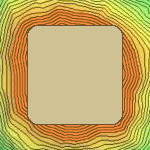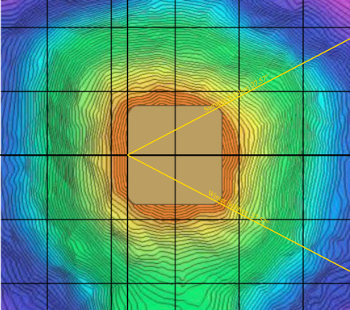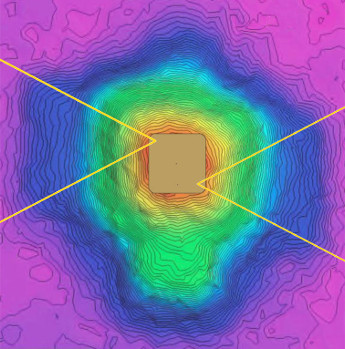
|
Letchworth-Love Mound
and Solar Timekeeping |
Timekeeping
=>
The Mound
=>
The Top
=>
Conclusions
|
First, let it be noted that everything here regarding the possible geometry of the top of
the central mound is an approximation or best guess. A closer analysis using higher-resolution
source materials and/or different methodology would likely produce a somewhat different result.
That said, the result is a far better fit than I had expected to find. In order to accurately observe the seasons, three points of reference on the horizon are required: due east/west for the Vernal and Autumnal Equinoxes, the Sun's southernmost position for the Winter Solstice, and the northernmost for the Summer Solstice. The Solstice positions occur an angle relative to the east/west baseline which is unique for each latitude. |
|
|
This diagram illustrates how to derive the ideal proportions for a platform at a given
latitude with an observer at the middle of the west side. (The builders would have derived them
empirically from prior observations.)
s is the Solstice angle, as determined by the Earths's declination
(tilt) of 23.5° and the latitude:
s = asin (sin(declination / cos (latitude)) Letchworth-Love Mound is located at 30.5° N latitude, so: s = asin (sin(23.5° / cos (30.5°)) ==> asin(0.399 / 0.862) ==> 27.57° b is width of the platform a = (b * tan(s)) The aspect ratio of the rectangle is (width / height), or (b / (2 * a)) For a width of 1, the aspect ratio is (1 / 2a), or (1 / (2 * tan(s))) Thus for 30.5° latitude the ideal aspect ratio is (1 / (2 * tan(27.57°))) ==> 0.958 The reconstructed platform is: Width (E-W): 94 pixels ==> 14.9 meters ==> 48.9 feet Height (N-S): 98 pixels ==> 15.6 meters ==> 51.2 feet Which yields an aspect ratio of (94 / 98) ==> 0.959. Given the approximations and assumptions made in the virtual reconstruction, such a close match is admittedly unlikely but not unreasonable. |

Ideal viewing platform proportions.

Reconstructed platform.
|
|
As the image shows, for an observer on the middle of the western side of the platform, the Sun
will rise over the northeast corner of the platform on the Summer Solstice, and the southeast
corner on the Winter Solstice. This was the kind of alignment I was expecting might surface, but further exploration with the Solstice lines produced two very unexpected results. |

Lines showing Winter and Summer Solstice sunrise angles.
|
| There are two low platforms, one on either side of the main mound, that are puzzlingly offset - the one on the west to the north, and the one on the east to the south. It turns out that for an observer on the northwest corner of the platform, the sunset Solstices occur over the corners of the western one, and for an observer on the southeast corner, the sunrise Solstices over the eastern one. |

Winter and Summer Solstice angles over lower platforms.
|
|
In conclusion, this exercise has demonstrated that geometry of the central Letchworth-Love
mound could have been
compatible with use as a solar Solstice observatory. But let me be totally clear: I don't
claim to have proven anything. That is outside my realm of expertise; I would hope,
though, that someone reading this might be inspired to take it further. We can never know for sure what this place meant to the people who lived here, particularly as the original builders were replaced by other cultures over time. In attempting to understand them however, we should never make the mistake of thinking they were any less capable or intelligent than modern humans, and we should always keep in mind that while the outward forms of their lives were very different, they experienced life much as we do. |
|
© 2024 Michael L. Wright